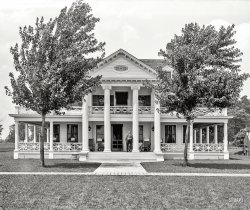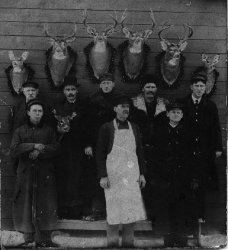
MAY CONTAIN NUTS

Search Shorpy
SHORPY ART

Framed or unframed, desk size to sofa size, printed by us in Arizona and Alabama since 2007. Explore now.
Join and Share
Ad-Free Shorpy
Shorpy is funded by you. Patreon contributors get an ad-free experience.
Learn more.

Recent comments
- Details, Details
- What's that building to the left of the tower?
- Coal Barges
- Bromo-Seltzer
- Inner harbor
- The Basin
- What a headache!
- Giant stepladder?
- Baldwin 62303
- Baldwin VO-1000
- Cold
- No expense spared
- Tough Guys
- Lost in Toyland
- And without gloves
- If I were a blindfolded time traveler
- Smoke Consumer Also Cooks
- Oh that stove!
- Possibly still there?
- What?!?
- $100 Reward
- Freeze Frame
- Texas Flyer wanted
- Just a Year Too Soon
- WWII -- Replacing men with women at the railroad crossing.
- Yes, Icing
- You kids drive me nuts!
- NOT An Easy Job
- I wonder
- Just add window boxes
Member Photos
The Shorpy
Print Emporium
Print Emporium
Search Shorpy
Search results -- 30 results per page
- Michigan Avenue: 1941
- Chicago, July 1941. "Stop light, Michigan Avenue." 35mm nitrate negative by John Vachon for the Farm Security Administration. View full size.
N. Michigan This looks like North Michigan at the foot of the "Magnificent Mile," perhaps. The barely-seen white ... Posted by Dave - 11/15/2011 - 6:38am -
![Michigan Avenue: 1941 Chicago, July 1941. "Stop light, Michigan Avenue." 35mm nitrate negative by John Vachon for the Farm Security Administration. View full size.
N. MichiganThis looks like North Michigan at the foot of the "Magnificent Mile," perhaps. The barely-seen white stone structure at the top of the photo looks like the Water Tower, sole survivor of the Great Fire of 1877.
Water Tower PlaceThere's not many places were Michigan Avenue jogs to right as shown above. And the building in the background is one that is particularly famous: the Water Tower. So this appears to be the intersection of Michigan Avenue and Superior Street (currently one-way, heading east). None of the buildings other than the Water Tower still stand.
The most shocking for me is seeing all those nice grass sidewalk lawns in the midst of an area that is now very densely urban.
BustlingWhat are you all talking about? I count 15 people not in cars. Now that's crowded!
Taxi questionI've noticed in the pictures of New York cabs and now Chicago had peculiar cutaway fenders as well as open rear roofs. What's up?
[The low-maintenance fenders and landaulet roof were design features of the Checker Model A. - Dave]
So PeacefulLooking at this photo you would never believe Europe & Asia were in the middle of a war.
Hanging a leftI find it interesting that the Left Turn Only lane has traffic turning before the actual light stanchion. Would it be safe to assume the street that traffic was turning onto was a one-way street? If not, it might wreak havoc if the oncoming traffic was making a right turn on red.
Sunday morningWhere IS everybody?
Train of ThoughtLooks like somebody's model train layout. And they did a really good job with all the period correct cars and billboards. It just doesn't look real -- perhaps more because of the aerial angle than anything else.
"Gasolene"For a slimmer carbon footprint.
FrozenWhat an interesting affect; this photo looks like it was taken of a diorama of some sort. There is a feeling that one could just reach down and rearrange those model cars at will. Makes one feel like Rod Serling! I think it is accentuated by the perceived lack of people; there are only seven visible.
Gasolene?I've seen it spelled this way in the Caribbean, but never here in the US. Was this an accepted spelling at the time, or something Cities Service did to distinguish itself from the rest of the crowd?
Kist againStar-kist yesterday (Air Race) and Sunkist today. Is there a theme starting here?
ChangesI found it on Streetview, luckily. Everything is different except the ornate little building in back.
VestigesAbout the only thing left in this picture today is the old Chicago Water Tower, the masonry building the bottom of which is partially visible at the top of the photo. That upper street is East Chicago Avenue.
This is not my Michigan AvenueJudging by the clock on the Sunkist sign, it's 3:05 p.m. And for the lack of people, I'm guessing that North Michigan Avenue was not the hot shopping area. South State Street had Carson's and Field's with their large stores. Watch out -- no traffic lanes. That gas station is long gone, too bad, it's a nice looking building. Walgreen's is now on the the east side of Michigan. And that's the famous Water Tower, cut off at the top of the image.
Late Model and UpscaleIt seems that the majority of the cars are late model and upscale.
Michigan & SuperiorThis view is taken from the intersection of Michigan Avenue and Superior Street, looking north toward Chicago Avenue, where Michigan bends to the right. In the upper right hand corner you can see a sliver of the famous Chicago Water Tower (W. W. Boyington, architect, built 1869), the best known survivor of the Great Chicago Fire of 1871. Needless to say, other than the Water Tower itself, every single building in this picture has been demolished.
East Superior StreetThe intersection below is Superior Street and Michigan Avenue, and the street to the north is Chicago Avenue. You can see the base of the Old Water Tower at the top of the image.
Miracle MileMarvelous image. Very likely we're looking north on Michigan, with Chicago Avenue intersecting near the top. What appears to be the base of the Chicago Water Tower is at the top, where Michigan kinks just a click to the NE. Charmette's Restaurant was located on the SW corner of Michigan and Chicago for many years. Spent many hours there in the late 50s, often in the company of a pretty girl from Navy Pier. Were we able to peek west on Chicago about three blocks, we would no doubt see men dancing with their wives.
Needs some careful weathering.As a diorama-maker myself, I'd say one thing that makes this scene feel less-than-realistic is the near-uniform grayness of the streets (especially for longtime Shorpy fans who are used to seeing road apples and horse urine in many of the older photos). This looks like brand-new pavement. If I were crafting this one, I'd definitely add oil stains, more tire tracks, maybe a pothole or two, and more manhole covers. While I was at it, I'd do something about the turf; it definitely looks fake. By the way, I love this picture. It'll be my desktop wallpaper for a while.
The best photoof a real photo imitating a model builders skill, and can this be the cleanest street in the world?
Double-decker busI doubt there are many cities in the US still using double-decker buses on regular commuter routes. I know of only a few in California. Some cities have them for tourist use including NYC and Las Vegas. I think they might be a better option than the long accordian buses that take up so much street space.
AfterthoughtI'd bet the reason for the odd and decidedly unsafe configuration of the left turn lane is a desire to avoid relocating the pre-existing traffic signal fixture. This is a workaround that would certainly not meet today's engineering standards, but reflects the evolving practice of the day.
I've seen the "gasolene" spelling from the turn of the century to the '20s, but never this late. At some point, I think there might have been a desire for a spelling consistent with kerosene.
Totally changedI lived two blocks west of here for 17 years starting in the late '70s, and still didn't recognize the location until I saw the old water tower. The lots with Sunkist signs and gas station had a series of small one-story buildings when I lived there, including a McDonald's and later a Banana Republic. For years there was also Evan's furs in the center of that block, a four-story building.
At Huron and Michigan (the intersection behind the photographer, not seen here) we had a Woolworth's! Complete with Luncheonette counter the length of the store. At Chicago Ave and Michigan, we had Wag's, the coffee shop of Walgreen's. My co-workers and I used to have lunch at Wag's when we worked at the Playboy (Palmolive) building.
Michigan Ave wasn't much of a shopping street until the late 1970s, when Water Tower Place went up. Just offices, hotels, apartments, and a few very upscale shops like furriers and jewelers (and Woolworth's!) The ad agencies were in this area. There were some great dive bars on Ontario, including the Inkwell, where all the Playboy people went after work.
More PeopleI got to this one a few days late but my old eyes (with a magnifier app) pick out 20 folks on the sidewalks here.
Clockwise from lower left:
2 at lower left
2 behind a car at the front door of the Gasolene station
7 strolling in front of Walgreen's
1 at the curb infront of Walgreen's, talking to someone in the car parked there
2 on the bench at the corner, facing the cross street
2 on the far side of the cross street
1 crossing at the crosswalk
3 on the opposite side of Michigan Ave (hard to distinguish but I see 3 shadows on the pavement).
Please correct me if I'm mistaken, or if you find even more.
(The Gallery, Cars, Trucks, Buses, Chicago, Gas Stations, John Vachon)](https://www.shorpy.com/files/images/SHORPY_8a32786a.thumbnail.jpg)
- Michigan Avenue: 1962
- ... Illinois, circa 1962. At 10:27 a.m. Looking north along Michigan Avenue at Adams Street, with the Chicago Art Institute on the right. ... kid with the white mother would one day be President.
Michigan and Adams 2008 Seems to be a new high-rise next to the Art ... Posted by shawnv - 12/04/2008 - 12:05pm -
![Michigan Avenue: 1962 Chicago, Illinois, circa 1962. At 10:27 a.m. Looking north along Michigan Avenue at Adams Street, with the Chicago Art Institute on the right. View full size.
What they didn't knowJust think of all the things these drivers and pedestrians didn't know...
They didn't know there was going to be a band called the Beatles which would have such an impact on the culture
They didn't know that Vietnam would dominate the news and effect huge cultural change
They didn't know Kennedy would be killed within a year or so...
They didn't know that in 7 years the impossible would come true, men on the moon
They didn't know we'd become so dependent on some weird electronic device called a home computer
They hadn't heard of or seen: Doctor Zhivago (1965); Dr. Strangelove (1964); The Graduate (1967); A Hard Day's Night (1964); Mary Poppins (1964) etc etc etc
They never saw a roofed sports stadium (Astrodome 1965)
I love to ponder these things and try and get into the head of people in old photos... What are they thinking? What's important to them this day while they are turning left? Do they have a doctor's appointment? A first date? Cheers!
Wow.A pink Edsel in turn lane. Wish I had one today.
[Not quite. That's a Mercury. - Dave]
Car SpotterPart of me wishes I was 20 years old in 1962. I love the 1957 to 1962 cars. From left to right, 1959 Ford, looks like a 1956 Plymouth grille behind it, the photographer is following a 1957 Olds, and yes that is a pink 1957 Mercury. In front of that looks like a Checker Cab. Next to the Mercury is a 1962 Oldsmobile, and behind it is a 1955 Chevrolet. Behind the 55 Chevy is a 1960 Chevrolet.
The PrudentialWas the tallest building in Chicago at that time I believe. Also, my dad works there. Good view of Grant Park!
They also didn't know...... that the little black kid with the white mother would one day be President.
Michigan and Adams 2008Seems to be a new high-rise next to the Art Institute.
View Larger Map
Car StylingIf this picture were taken today, one wouldn't see much difference in car details. Most vehicles for the past 10 years have looked about the same. But in this picture, such amazing variety in just a seven-year span of models! Somehow, uniformity makes our society poorer.
So much has changed...... But one thing hasn't - THE TRAFFIC!
Chicago ..."My Kind of Town," so sayeth the chairman of the board.
MusicThis photo is best viewed while listening to The Thrashmens classic "Surfin' Bird"
Eerie how that happened to be playing here precisely when I saw this photo.
Changed?Honestly, this intersection really hasn't changed much. I recognized it right away. Go a few blocks in either direction, and there will be plenty of new stuff, but not at this intersection.
On a weekend with a car show, you could probably take nearly the same picture.
Car Styling I agree with you on that. It wasn't until recently that cars went through another design revolution. The minivans in the '90s and early '00s. At least now there are some differences between them. They all had the same shape and looked exactly the same from a distance back then. Same thing with mid-sized sedans. It was only in the last year or two that the cars gained some new distinguishing styles. Nothing beats the old cars though.
Palmolive Building mastThe tall silver mast on the Palmolive Building was the WGN-TV antenna back in those days. I believe it's used by an FM station now.
PrudentialThat's the Prudential Building with the mast. The Palmolive (a.k.a. Playboy) building is farther north and not visible in this photo.
That one modern buildingI walk by that spot all the time. The modern Prudential building dominating the photo was the first big Chicago skyscraper after a 20-year Depression/WWII hiatus.
Compare to all the buildings lining Michigan Ave which date from the 1910s and 1920s. Most are still there.
CarsAs for me and my family we would rather be in one these old big safe cars than the Tinkertoy cars of today.
[I'd rather be surrounded by six airbags and two crumple zones. The death rate per passenger-mile circa 1960 was pretty horrific. Those big old cars (and their passengers) did not do especially well in collisions. Roofs in the era of the wraparound windshield did a poor job of supporting the weight of the car in a rollover. - Dave]
No squabbleI was half as tall as my sister so the hump was my pillow. I loved to hear the rush and rumble of the road through the floor and, if my dad stopped too fast, I couldn't roll off.
ExactlyFeel the same way AJ, I can spend hours watching and analyzing every bit of these photos. Wish I had a time machine.
Old CarsThose old heavy cars used to have a lot of decapitations. The hood was solid and heavy and in a collision would release from the hinges and go back through the passenger compartment and slice off heads. As Dave stated, today's cars have crumple zones so the hood now just crumples up on impact... Much safer.
[Cars now are generally heavier than their counterparts 50 years ago, or at least denser. A 1959 Ford and 2009 Honda Accord both tip the scales at around 3,500 pounds. My Japanese car weighs a little over 4,100 pounds. - Dave]
Backseat SquabblersThe first car I remember was the family's green and white 1959 Ford Galaxie. My sisters and I used to fight over who got to sleep in the back window ledge on the way home when we would visit relatives in South Dakota. Winner got the package-shelf perch, second place got the back seat, loser ended up on the floor on hump. Actually we traded off, but the window shelf was prized. Riding like that with a Dad that smoked, it's a wonder we survived! Yikes.
1961It could have been taken in 1961, since the center green car is sporting a 1961 Michigan tag, which is the 59 yellow on green with a silver 1961 metal tab. Illinois had white on red plates in 1961, white on orange in 1962 - colors too similar to identify in the photo. Could also have been early 1962, but I think we’d notice both orange and red IL plates. As a kid in Chicago, I loved to see new plates appear each winter.
Route 66The white sign on the lamppost (in front of the lion) marks the beginning of Route 66.
Clues from the U.S. FlagWe featured this picture as our quiz #188 photo for the week of 14 Dec 2008. We essentially asked readers to identify the location and to tell us how they recognized it. See
www.forensicgenealogy.info/contest_188_results.html
We received many responses - one from regular reader Mike Dalton was worth writing to Shorpy about. Mike dated the picture to after July 4, 1960 based on the admission of Hawaii and Alaska to the Union in 1959. As Mike wrote:
Timeline referencing 50 star American flag in photo:
Alaska entered Union on January 3, 1959 - rank 49th state;
Hawai'i entered Union on August 21, 1959 - rank 50th state.
President Dwight David Eisenhower signed Executive Order 10834 on August 21,1959, regarding design and implementation of 50 star American Flag.
50 star American Flag raised officially for the first time at Fort McHenry National Monument in Baltimore, Maryland on July 4, 1960.
Since the flag on the front of the Art Institute of Chicago has 50 stars on it, the photo had to have been taken after July 4, 1960.
=====================================
[The earliest this could be is late 1961 -- that's a 1962 Oldsmobile under the Prudential tower. - Dave]
I am amazedDave. Your knowledge amazes me. Not many folks can identify a 1962 Olds.
Ferris BuellerIf you ever saw Ferris Bueller's Day Off, you could see this is the Art museum from that movie. It shows the lions at the beginning of the museum montage played to the instrumental version of "Please Please Please Let Me get what I Want" by Dream Academy. Great movie.
Some things never changeThe spectacular "Lions of Michigan Avenue" in front of the Art Institute, placed there in 1894, are considered the best work of artist Edward Kemeys. They're not identical; the lion on the north pedestal is "on the prowl" while the one on the south pedestal is "in an attitude of defiance." I have pictures of my family in front of the south lion when our children were small. We used to eat at Bennigan's (no longer there) directly across the street, gazing (if we were lucky enough to get a window table) out at the Art Institute and the southern end of the Magnificent Mile. I took a picture looking west down Adams Street towards the Sears Tower (it has another name now but I never use it) from this very spot in late September of 2019. Then there's that lovely peek of the Wrigley Building glowing in the distance to the north -- Michigan Avenue at Wacker Drive, where the Chicago River flows beneath the DuSable Bridge.
(ShorpyBlog, Member Gallery, Cars, Trucks, Buses)](https://www.shorpy.com/files/images/chicago_2.thumbnail.jpg)
- Winter Crossing: 1900
- Circa 1900. "Detroit River. Car ferry Michigan Central entering slip." 8x10 inch dry plate glass negative, Detroit ... can feel a smell of it. Wonderful! Just great!
"Michigan Central" This seems to be the same sidewheeler design as in ... Posted by Dave - 08/02/2012 - 3:18pm -
![Winter Crossing: 1900 Circa 1900. "Detroit River. Car ferry Michigan Central entering slip." 8x10 inch dry plate glass negative, Detroit Publishing Company. View full size.
Who's with me?Winter break on the Detroit River!
Frigid WonderThis is just a beautiful photo, of an otherwise thoroughly utilitarian scene, just barely romanticized by having train cars and a paddlewheeler as subject matter.
The texture in the broken ice at foreground, the impressionistic smoke, and mist in the distance -- Wow.
Brr.I'm getting frostbite just looking at this picture.
All aboardI see the three sets of tracks, but would like to see the actual way they load and unload the box cars. I bet the guy smoking the pipe could have told us.
Extraordinary!This is an extraordinarily beautiful photo. The black and white textures are remarkable. I can feel the cold air and hear the ice crunching as the ferry drifts in. The ghostliness of the image is echoed in the misty distant skylines, and the whole is anchored by the two figures.
What a composition!
SkylineDoes anyone know if the ferry is pulling into Detroit or Windsor? Any clue from the church in the distance?
Interesting weatherCloudy, with a 100% chance of thumbprints!
Link & PinThe center car seems to be fitted with a link & pin coupling. The Railroad Safety Appliance Act took effect in 1900 outlawing these hand crushers on railroads engaged in interstate commerce.
Absolutely wonderful!As a person who lived in Archangelsk city, I used to see a scenes like this many many times. I feel the atmosphere, I even can feel a smell of it. Wonderful! Just great!
"Michigan Central"This seems to be the same sidewheeler design as in the previous shot of a car ferry, the "Transport." The names (hard to see) are stenciled on a signboard over the wheelhouse.
A ferry wonderland"The Great Lakes Car Ferries" by George Woodman Hilton has another photo of the Michigan Central on page 35.
Best. Photo. Ever.I've been reading Shorpy regularly since sometime in '07 when I saw a link on either Boing Boing or Neatorama. This is abso-freakin-lutely the Best. Photo. Ever. Bless you, and keep doing what you do.
Over the riverAt about this time, my grandmother may have been on a sleigh on the frozen river, on the way back to Windsor from Detroit, smuggling back cotton socks. She would have been 10 years old.
Such was the family story.
Great photoI am so impressed with the high contrast in the sky. If it were not clearly labeled as a scan directly from the negative, I would have assumed this was a print which had received a lot of attention in the darkroom.
This image is one of Shorpy's all time greats.
[All of the images on this site are adjusted for contrast in Photoshop. - Dave]
57 summers laterBelow is a scan of a 35 mm Kodachrome slide showing this same rail car ferry yard as it looked on July 6, 1957. The photo was taken from the deck of the Ambassador Bridge and its viewpoint is 180 degrees from that of the 1900 photo (the bridge was built during 1927-1929). View full size.
The church steeple seen in the distance on the 1900 photo is located in Windsor, Ontario. Here's a photo of it taken from the bridge deck just seconds prior to the one of the rail car ferry yard in Detroit.
Jules VerneyUntil you focus in on the rail cars, and the pictures resolves into the recognizable, there's a kind of Victorian Future-Shock quality to it.
Frozen in timeThe sharpness of the broken crystal shards could kill a man, they stand pointed end up, ready to cut a careless worker or walker, like razor-edged beveled glass. Two men are seen, yet each is lost in their own solitary thoughts. Possibly thinking "damn, it's cold."
Final departureIt looks like they are taking boxcars full of the damned over the river Styx.
The church might be in WindsorIt looks very much like Our Lady of the Assumption Church near the foot of Huron Church Rd. It is still there, presently in the shadow of the Ambassador Bridge.
If so, the view is downstream.
Detroit RiverThis is the Detroit side. The river flows extremely fast, and the ferry docks were set up so the boats always entered dock facing upstream. Michigan Central was built in 1884 by Detroit Dry Dock in Wyandotte, while Transport was built there in 1880. Both were cut down to barges by the 1930's. A nearly identical boat, Lansdowne of 1884, survived in steam until 1970 for CN/Grand Trunk, until she blew a cylinder head (I remember the shock among the Detroit trainwatching community at the time).
Her long survival was due to the limited size of the RR tunnels under the river, which couldn't handle hi-cubes and other large cars.
Lansdowne then became a floating restaurant, with two Milwaukee Road Skytop observation cars aboard. Recently scrapped in Buffalo.
I frequently went down to watch Lansdowne and an even older propeller ferry in the days of no security, "Sure, just be careful!"
WindsorI live in Amherstburg, about 20 miles downriver from Windsor. I love these photos of the Detroit River.
Great StuffI love these pictures of the Detroit River railroad ferries. My grandfather worked on these boats when he first came to Detroit from Pennsylvania in 1919. I remember watching them shuttle across the river during my childhood in the '60s and '70s.
Does anyone know what that factory on the right is? Is it the Michigan Peninsular Car Co. (aka American Car & Foundry)? It seems to be in basically the right place on the west side of Detroit. My great-grandfather, on the other side, worked there.
Building a ModelI'm building a 1/87 model of the train ferry Windsor, and these pictures and diagrams have proven to be invaluable.
Thanks, Terry Jolliffe
Belle River, Ontario
(The Gallery, Boats & Bridges, DPC, Railroads)](https://www.shorpy.com/files/images/4a04912a1.thumbnail.jpg)
- Pumped in the Park: 1901
- Ottawa County, Michigan, circa 1901. "Crescent Walk, Macatawa Park." 8x10 inch dry plate glass ... Posted by Dave - 04/29/2024 - 3:05pm -
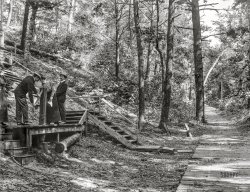
- Michigan Avenue: 1918
- Chicago circa 1918. "Michigan Avenue -- Blackstone Hotel and Grant Park." 8x10 inch dry plate glass ... street lamps are still in use today.
Original Michigan Blvd. Lampposts The unique originals were replaced in the '50's by ... Posted by Dave - 10/27/2015 - 10:48am -
![Michigan Avenue: 1918 Chicago circa 1918. "Michigan Avenue -- Blackstone Hotel and Grant Park." 8x10 inch dry plate glass negative, Detroit Publishing Company. View full size.
Trees, please. Thank you.
Amazinglythose multi-globed street lamps are still in use today.
Original Michigan Blvd. Lampposts The unique originals were replaced in the '50's by a bland street lighting design eventually used throughout the city. These 50's replacements are still in use in most areas in Chicago proper. Later use of sodium vapor in the lighting elements, these newer fixtures have contributed to the "Orange-ing" of Chicago which sets the city streets apart from those of the suburbs.
Even though these replica lampposts use sodium lamps (orange), I was glad to see them return!
Still looks beautifulFunny, with the decline of Detroit in the news so much I was expecting this hotel and entire block to be gone or abandoned. It's nice to see that the hotel appears to be as beautiful as it was in 1918.
[This is Chicago, though. -tterrace]
Oohh...Detroit PUBLISHING company. Thanks tterrace. I saw Detroit at the bottom in the description and got it in my head. Thanks for setting me straight. I had a moment of hope for Detroit! :)
+89Below is the same view from April of 2007.
Art Institute of ChicagoThat would be the Art Institute in the distance on this side of the street - also still there in the same building.
Stick It To 'EmThe billboard to the left of the Blackstone advertised Thrift Stamps that were being sold to the public to aid the Liberty Loan drive during WW1. They sold for 25 cents each.
and could eventually be traded for interest bearing War Bonds. We had similar stamps during WW2 but they could be purchased for as low as a dime.
BlackstoneI have stayed there a few times, actually. Neat old building. A ton of movies were filmed there too!
(The Gallery, Chicago, DPC)](https://www.shorpy.com/files/images/SHORPY-4a24940a.thumbnail.jpg)
- Family Vacation: 1951
- ... 1951 speed limit was on cars towing trailers?
Location Michigan Or at least that's where our young man and his family are ... Burt Lake State Park is in the northern part of the Michigan glove. Love how the Plymouth (I think it's a 1950 model) and the ... Posted by Dave - 08/18/2012 - 10:41am -
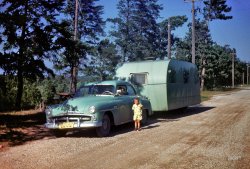
- Michigan Mystery#2
- ... a camping trip from the watertown area of Wisconsin into Michigan through Michigan's Upper Peninsula. I'm trying to figure out where these were taken, ... Posted by mamyers - 08/24/2012 - 9:45pm -
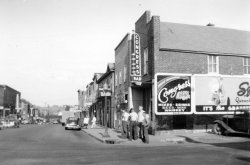
- Michigan Avenue: 1942
- February 1942. "Chicago, Illinois. Michigan Avenue." Medium format acetate negative by John Vachon for the Office ...
Conrad Hilton Hotel on the left This view of South Michigan Avenue is taken from just south of Balbo Drive (formerly known as 7th ... Posted by Dave - 08/20/2021 - 10:52am -
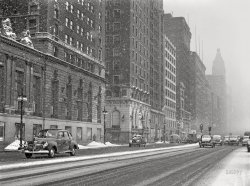
- Noel, Iola: 1944
- ... 4, 1918:
"Gerald Swinnerton, 31, of Williamston, Michigan, and Iola Taylor, 18, of Rockford, Illinois."
Iola in 1947 Here ... Posted by Dave - 12/24/2023 - 11:31am -
![Noel, Iola: 1944 On this Christmas Eve, we travel back 79 years for a visit with the First Lady of Shorpy, Iola Swinnerton. Some two decades after her bathing-pageant days, she is still radiating beauty and cheer. Scroll down to the comments for more of Iola's life story. View full size.
"STONE WOMAN" ENJOYS
CHRISTMAS PREPAREDNESS
CHICAGO (Dec. 23, 1944) -- Mrs. Iola Swinnerton Warren, who suffered the illness known as myositis ossificans after inoculation for typhoid following a Florida hurricane, watches her husband Theron V. Warren and little nephew Herbert Taylor trim Christmas tree. (Acme Newspictures photo.)
Licensed to Marry.From the Washington Post of August 4, 1918:
"Gerald Swinnerton, 31, of Williamston, Michigan, and Iola Taylor, 18, of Rockford, Illinois."
Iola in 1947Here is part of article from the Waterloo Sunday Courier (Waterloo, Iowa) of March 9, 1947. The Warrens adopted Herbert Taylor (Iola's nephew). Herbert was 13 in 1947.
Forever YoungIt would seem, from an earlier comment, that she was born in 1902, so she would have been 19 or 20 in those earlier photos from 1921 and 1922, and 42 here. She has lovely, youthful skin and a radiant smile.
[If she was 18 when married in 1918, she'd have been born in 1899 or 1900. - Dave]
Not just Christmas celebrationsThis is also the occasion of their second wedding anniversary - I found the announcement from the Suburbanite Economist (Chicago) of December 23, 1942. It sounds like she had a terrible time with this illness -- it started in 1926 and she spent nine years in the hospital! I'm glad she seems to have found happiness with Theron.
Based on what I read about myositis ossificans, it seems unlikely that this is what she had. It is normally caused by an injury to a muscle, and from what I can tell, stays within that muscle -- it doesn't spread to other areas of the body. It's probably more likely that she had heterotopic ossification, possibly caused by central nervous system injury or an underlying genetic disorder.
*Cringe*I am sure that Herbie really enjoyed being characterized in the newspaper as her "little" nephew.
Hope his friends didn't see the story!
[He looks like Larry Mondello. - Dave]
Carpentry and TweedNotice the nicely done rest for her feet that does not appear to be part of the original wheelchair--not the easiest thing to put together if you're doing it with nails instead of wood screws, which may be the case here. Also, I love the nephew's tweed slacks--sadly, winter weight slacks seem to be a thing of the past, even up north here in Minnesota. They're keeping him so warm, he doesn't need to keep his shirt tucked in.
The story that keeps on givingAnother amazing feature of this website. Over the course of eleven and a half years (dating back to April of 2007) we are treated to a series of photos of Iola Swinnerton from a very specific two-year period (1921-1922) in a very specific context (bathing suit beauty contest). No sense of limitation or lack of variety, and every new photo was a delight.
Flash forward suddenly 22 years to 1944 and to a whole new context. We find Iola in a wheelchair with a strange and rare disease, and yet she is happy, recently married to a benevolent-looking church organist, and she and her husband have adopted her nephew. The husband "wasn’t discouraged because the pretty invalid was confined to a wheelchair," and she is able to report that her "condition has steadily improved" since they got married.
The crowning glory of her positivity: "My dreams during so many years in hospitals have come true." (She writes songs which are published!) "I only hope someone else can take hope from my happiness." This is one of the most truly marvelous stories I've ever come across.
Stiff Man’s SyndromeIola may have had what is now called Stiff Person’s Syndrome. It was first diagnosed in 1956.
A friend had it.
IolatryHere's a few more details regarding Iola.
The New York Times, while reporting her wedding, stated that she was earning her living as a seamstress. The paper also said, "She was stricken by the baffling disease after the Florida Hurricane of 1926. At that time she lived in a Miami Beach cottage, the wife of Gerald Swinnerton, whom she divorced in April, charging desertion."
In the 1940 U.S. Census Gerald Swinnerton is claiming to have been widowed. He was a camera designer and repairman, as well as a World War I veteran, and he was also known as George Simons. He died in 1961.
Regarding her wedding, the Chicago Tribune of December 24, 1942 published the following story.
"Smiling from her wheelchair, in a moire taffeta wedding dress and a shoulder length tulle veil, Iona Swinnerton, 40 years old, was married last night to Theron Victor Warren, 42, a shipyard worker and organist in the Wentworth Baptist church. The bride is suffering from a rare disease characterized by hardening of the muscles.
"About 100 relatives and friends were present as the Rev. Eugene H. Daniels read the marriage ceremony. L. Duke Taylor, 1918 Cleveland avenue, her brother, gave the bride away. Donald McGowan, 1954 Henderson street, was the best man.
"Miss Swinnerton, who lives at 4044 Wentworth avenue, has been suffering from the malady since 1926. She teaches a Bible class at the church, and met Warren while attending the services there."
An article in the Cedar Rapids Gazette in December 1945 indicated that she had spent six years at the Cook County Hospital for treatment of her condition. She was refinishing furniture and canning fruit in addition to writing songs. "Theron proposed not very long after I cooked him a duck dinner," she confided.
In 1949 Iola won fourth place in a nationwide Army songwriting contest, which earned her a $50 savings bond. The title of the tune was "Three Cheers For the Army." She died five years later, in 1954. Her obituary from the Chicago Tribune is below.
"Iola N. Warren, 2642 Barry avenue, June 13, 1954, beloved wife of Theron V. Warren, dear sister of Louis Duke Taylor, dear aunt to Herbert Taylor. At chapel, 316 W. 63d street, at Harvard avenue, where services will be held Thursday, June 17, at 1 p.m. Cremation Oak Woods."
Theron Warren died on May 3, 1976.
The image below is from the January 4, 1937 issue of the Wilson (N.C.) Daily Times.
FOPI presume Iola had fibrodysplasia ossificans progressiva.
Story of Two FamiliesLuckily, I accepted an invitation to the Swinnertons' Christmas party before the invitation to the Dickeys' Christmas party arrived.
Three cheers for King CottonThe pants of the kid look as if they are scratchy. Ask me how I know.
It’s a small worldI’ve been a long-time Shorpy lurker, and have many of the wonderful images saved as desktop wallpaper.
I had to comment on this picture -- the Eugene H. Daniels mentioned as the officiant in the newspaper article was my great-grandfather! By the time I knew him, he was just “Grandpa Dan”; it’s neat to be able to read about Iola and Theron some 78 years later.
Merry Christmas to all!
Eeugh!Theron is a ringer for an ex of mine. I hope Iola had better luck--she certainly endured enough as it was.
(The Gallery, Chicago, Christmas, Iola S., Kids, News Photo Archive)](https://www.shorpy.com/files/images/SHORPY-1368.thumbnail.jpg)
- Michigan Mystery #2 Solved
- I located a street view from the other side of the street of the Congress Bar. When you compare both photos, you can clearly see they are looking down the same direction. There's a train bridge going over the street in the distance and some of t ... Posted by mamyers - 08/26/2012 - 5:50pm -
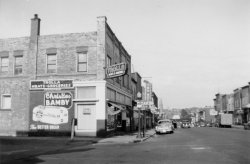
- Beach Policeman: 1922
- ... early 1900's for showing too much leg at a beach on Lake Michigan. Great pictures.... Al . Sacramento, Ca.
Modesty, Please! ... Posted by Ken - 08/31/2022 - 12:51am -
![Beach Policeman: 1922 Commemorating the Potomac Thighway Patrol's 100th anniversary, and one of Shorpy's most popular posts --
June 30, 1922. "Washington policeman Bill Norton measuring the distance between knee and suit at the Tidal Basin bathing beach after Col. Sherrill, Superintendent of Public Buildings and Grounds, issued an order that suits not be over six inches above the knee." 4x5 inch glass negative, National Photo Company Collection. View full size.
This poor guy would have a stroke......if he could see what our high schoolers are wearing to summer school this summer. I honestly don't know where to put my eyes.
And obesity does NOT stop them from wearing too little and revealing too much. I wish I could "un-see" some of this summer's ensembles! (Rolls of exposed fat, ripples, dimples, man breasts, and so much more...)
Side note: What you are hearing in the media about the increase of obesity among America's young people is true. As they entered the building today with their doughnuts and Gatorades and Rock Stars (breakfast they buy at convenience stores on the way to school!), I realized that the summer FACULTY is more trim and fit than the summer school STUDENT BODY. Of course, we *do* have a lot of coaches, male and female, working this summer, but still...
Oh my God, it's the REALOh my God, it's the REAL bikini inspector!
Bathing Suits RequirementsNo kidding! My grandmother was arrested in the early 1900's for showing too much leg at a beach on Lake Michigan. Great pictures.... Al . Sacramento, Ca.
Modesty, Please!Today he'd be looking for thongs. I wonder what the next step is.
Looking upI'm sure he hated his job!! Yeah right!!
Today he couldlook for bulbous folks who have no business wearing Spandex
My only question is...Where are the beaches in Washington, DC?!?!
[Along the Potomac or Anacostia rivers. This is probably near the Tidal Basin. - Dave]
Beaches in DCIs that the Washington Monument in the distance? With the Smithsonian Castle over to the right? That might put this at the swimming beach where the Jefferson Memorial is now.
Its a tough jobbut somebody's got to do it!!!
heaven forbidmen see more flesh than is already present...they just wouldn't be able to control themselves...monsters that they are...
RE: This poor guy would have a stroke...Awww... but these are sure some nice pictures on this site, eh?
sadthis picture is so disheartening. not saying that measuring women's bathing suits isn't a bit humiliating and patronizingly obnoxious, but why are our teenagers pretending they're porn stars?!
["Pretending"? - Dave]
MemoriesI remember being a kid and having someone measure the distance between my knee and my shorts. Even though you knew what you wore was long enough, it never stopped the butterflies caused by wondering if the man doing the measuring was going to think they were too short! What an embarrassing time!
Re: SadJust because some bratty little kids dress in very little at all doesn't mean they're pretending to be filming an adult movie. I'm sure there are people at the time of this picture who were offended by the girl's skimpy suits, but you don't really have to go off calling them porn stars.
Beach policemanNotice how they aren't measuring the men.
Well, look at the girls.Well, look at the girls. He's more like the "cover yourself up, fatty" inspector. Too bad we don't have those today...
Re: Well, look at the girls.You're an idiot. That's what real women used to look like before the media and anorexia started coming down on everyone. You think they had Twinkies and Ding Dongs back then to gorge on, while sitting in front of the TV? Those girls are not overweight. Your tiny mind has been warped by today's sick society.
D.C. "beach"The area where the Jefferson Memorial is today was once a segregated public beach.
Good Work If You Can Get ItSo, did she pass inspection?
I Knew It!I've suspected for some time that my job sucked. Now I have photographic proof!
The SwimmerI like that she's leaning forward. I'm pretty sure that'll slide the fabric down at least a little. Way to work the system, bathing suit girl!
Double Standards???I don't see any men in the picture, but do notice the boys in the background are wearing essentially the same outfits, which modern boys would consider somewhat uncomfortable, I'd bet.
You can see from the marks……above her knees that she had taken off her stockings only a short time before the picture was taken.
For the sake of HumanityIt's obvious that what our parents taught us didn't matter to us, nor did they care for their parents as well. People had envy for their integrity and honor, and people cared for one another as if they were family, it's sad to see our world slope down to a level beyond wearing bikinis, to a level where we are happy how our children become more and more as adults to copy what we call "celebrities" and where short skirts and show skin. In my search I have found the answer and the solution to this problem, I have found a religion so great. Over time and as skin began to increase people see it as being normal, and that covering up is so abnormal, demeaning and a violation to one's rights, it's the beginning of humanity where Adam and Eve try to cover up, it's in our nature, in reality I found what integrity really means, to me and my family. Although I am double searched at airports because of my religion but in the end I am happy and can lift my head up high, and be proud of our honor, and what we have become in a hateful and evil world.
[So in this evil, bikini-wearing world, you're finally feeling good about yourself? Super. - Dave]
On Our KneesWhen one can determine what the appropriate amount is required to be modest, then the only fashion will be that one definition... A lot of people need to evolve..
Hmmm. 1922?Nice pic - but perhaps the foreground images are a little bright, sharp and contrasty for a 1922 image? And a right click of the mouse and a quick squizz at the image properties reveal the use of a $25,000 Sinar digital camera back - and Photoshop CS3. Surely digitizing with a normal film or flatbed scanner would have been more appropriate? I do hope I'm wrong and that they are the real thing but...... Hmmmm.
[These images were digitized using a Sinar 54 scan back and then adjusted for contrast and turned from tiffs into jpegs with Photoshop CS3. - Dave]
ScannerDon't get your point - I would expect you to use a scanner - either a film or flatbed type - to scan these rather than a digital camera. Just curious to know why all the pix on the site put through the Sinar look slightly unnatural for their time, that's all. Maybe we're all used to faded images from the period.
[You wouldn't use a film scanner because there is no film -- these images were recorded on glass plates the size of windowpanes. Flatbed scanners are more suited to reflective media (prints) than transmissive media (glass plates, film transparencies, negatives). Plus, flatbed scanners would be much too slow. The single-exposure scan back (in this instance, made by the Swiss firm Sinar) is standard equipment in a lot of archival facilities where hundreds or thousands of images have to be processed every day. The principle behind each scanning method is the same, though -- light shines through the transmissive media being digitized and hits a semiconductor array. - Dave]
NecklacesThey have to be mother and daughter, related somehow...Matching necklaces...can we get a zoom in of the Medallions... please.. Dave? (Love this site by the way)
[Those are claim tags for the changing-room lockers. - Dave]
Integrity IS hard to find!It's really sad to be a 21 year old girl these days. Everyone I know is getting on their knees to get male attention instead of being subtle or witty. I'm reading and drinking coffee with my nose in a book. I think I've got the right idea, and my joints are no worse for the wear.
Washington PolicemanThe policeman in question is a member of the United States Park Police. At the time they were under the control of the Bureau of Public Buildings and Grounds. They eventually were transferred to the National Park Service when the Bureau of Public Buildings and Grounds was reorganized to create the General Services Administration.(GSA got the buildings and the Park Service got the grounds).
Some Warning, PleaseDave! Please! I had to clean my morning tea off my monitor. Too funny!
Fat Was Beautiful"Plump" was a compliment in those days. Look at the first 10 Miss America winners (not to mention Playboy centerfolds). The current idea that "Bony is Beautiful" is of fairly recent development and is a forced denigration of all that makes women biologically successful.
(For the "Yeah...sour grapes" crowd, I'm 5'2" and weigh 97 lbs. I wish I had a little more padding.)
Pull over miss!Pull over miss while I wrap my fingers around your knee cap! I bet his mother, his wife, his children, and his in-laws are so proud. How does he explain to his children what he does for a living? Yes, my dad measures women's bathing suits at the beach. Sooo funny. Nope, Madonna wouldn't put up with this. Note the little boy carrying (I think) a brownie camera in the back.
See him in actionYou can see our man in action in this YouTube movie, round the 3:10 and 3:40 mark.
Presidential dippingI notice the location may be along the Potomac. A trivia fact is that President John Quincy Adams loved to swim nude in the Potomac.
Reminders of mini-skirtsForty-six years after this, I was a freshman at Fort Knox High School. While the fashion was for skirts to be several inches above the knee, at FKHS, if they thought someone's skirt was too short, they would make her kneel on the floor. If her skirt didn't touch the ground, they could send her home to change. The very young VP was generally the one who did that. Since I had grown four inches taller in the previous few months, but my dresses hadn't, I did my best to avoid him!
Taking no chancesThe young girl on the extreme left is definitely not going to drown as she is wearing TWO, not just one, inner tubes around her waist and keeps them on either in or out of the water. Better safe than sorry.
Touch my leg??!!Is this the origin of the expression "cop a feel"? Just wondering.
A perfect illustrationof bureaucratic inefficiency. What's with the tape measure? If the law says six inches, all he needs to measure with is something six inches long, that he can press against ladies thighs. Hmmm....
[That wouldn't have made as effective a photo. This was shot for newspaper distribution. - tterrace]
Oh, it would have made an effective photo alright! I doubt they could have printed it in the newspaper, though.
Not Park PoliceHe is wearing a Metropolitan Police badge.
Very PresidentialI always wondered what FDR did in the 20's before becoming president!
The measure of a manMr. Sherrill had definite ideas about things --
"But this did not satisfy them""They wanted to play golf on the same days and at the same time as the white people." Imagine!
[Really. The nerve of some people! - Dave]
Get Back in Your BurkaWhy the ladies don't kick sand in the face of this doofus is a good question. I'm guessing the boys standing just behind are wearing suits just as short.
1963This very thing happened to me in high school on Long Island!!
I think I know what job I want when I grow upThe boys may be thinking this is the job for them!
(The Gallery, Bizarre, Curiosities, D.C., Natl Photo, Swimming)](https://www.shorpy.com/files/images/06624u.thumbnail.jpg)
- Toledo: 1909
- ...
Toledo and Ohio Central and Kanawha and Michigan were both absorbed by New York Central System. NYC as part of Conrail, ... Southern and CSX Trans.
Hocking Valley, Kanawha and Michigan and Toledo & Ohio Central and ... lots of Hocking Valley Railway , Kanawha and Michigan Railroad and Toledo and Ohio Central Railroad train cars to be ... Posted by Dave - 10/22/2011 - 7:24am -
![Toledo: 1909 Toledo, Ohio, circa 1909. "Maumee River waterfront." 8x10 inch dry plate glass negative, Detroit Publishing Company. View full size.
Long gone railroadsThese railroads are so long-gone, that the companies that took these over are also long-gone.
Hocking Valley Ry became part of Chesapeake and Ohio, which is in turn part of today's CSX Transportation.
Toledo and Ohio Central and Kanawha and Michigan were both absorbed by New York Central System. NYC as part of Conrail, was split up between Norfolk Southern and CSX Trans.
Hocking Valley, Kanawha and Michigan and Toledo & Ohio Centraland ... lots of Hocking Valley Railway, Kanawha and Michigan Railroad and Toledo and Ohio Central Railroad train cars to be seen.
Toledo? You ask how I know of Toledo, Ohio,
Well, I spent a week there, one day
They've got entertainment to dazzle your eyes
Go visit the bakery and watch the buns rise.
Code BreakerI wonder if all transmissions aboard the Jay C. Morse are done in code.
Spotted over above right, a roof hoarding advertising the Snow Flake Laundry, what a great name, hopefully not too indicitive of the weather patterns in Toledo.
Jay C. MorseThe ore freighter is named for the industrialist co-founder of one of the era's most powerful steel and mining companies (Pickands, Mather & Co.). In 1899, at age sixty, Jay Morse married Seville Hanna, the widow of his business partner James Pickands and sister of the sitting president's "Karl Rove," Mark Hanna. Morse died August 22, 1906, and on July 21, 1907 his widow helped to launch the steamship bearing his name.
Is it live, or is it Memorex?Please excuse the audio reference to obviously visual dilemma.
This looks like the most awesome HO train setting I've ever seen!
SS. Jay C. Morse Photographed here in her first year on the lakes, the Jay C. Morse, AmShip Cleveland hull #438, was in service for over seven decades. After a final few years as a lowly storage barge, she was scrapped in the 1980s. Her wheelhouse, removed prior to commitment to the scrapyard, was saved and made into a maritime museum in her last port, Goderich, Ontario. Comparison of the the 1908 photograph with the preserved wheelhouse/museum indicate either substantial rebuilding of the bridge or complete replacement during some mid-life refit.
Boatnerd.com has a 1980 photo of her during her final years as a grain storage barge.
The Scanner, Toronto Marine Historical Society, 1978.
The bulk carrier Jay C. Morse which was acquired early in the spring of 1965 from the Interlake Steamship Company and renamed Shelter Bay (II). After operating Shelter Bay for the 1965 season, Q & O [Quebec And Ontario Transportation Co.] decided that the ship was in need of reboilering. It was not thought that the cost of new boilers for such an elderly vessel could be justified and so Q & O searched for some good used boilers which might be obtained at a more reasonable price. The company did not have far to look and decided to purchase from Marine Salvage Ltd. the boilers which were then ensconced in Bayton.
In due course, workmen went aboard Bayton and commenced pulling apart the old girl's after cabin. Her stack removed and a hole chopped down through her upper decks, the Babcock and Wilcox water tube boilers were lifted from the vessel and were carted 'round to the West Street Wharf in Port Colborne where Shelter Bay was lying. During the summer of 1966, the boilers were installed in Shelter Bay and she has operated with them ever since. Q & O, however, might better have searched elsewhere for boilers rather than taking third-hand equipment for the conversion. In recent years, Shelter Bay has been plagued with boiler problems and a particularly nasty spate of difficulties during 1977 threatened to send the boat to the scrapyard. She was reactivated in 1978 for one further year of operation but continued struggles to keep the well-worn boilers in serviceable condition are almost certain to bring the ship to the end of her career at the close of the current navigation season.
The Scanner, Toronto Marine Historical Society, 1979.
The latter steamer [Shelter Bay (II)] went to Goderich last autumn with storage grain and was sold to the Goderich Elevator and Transit Company Ltd. for use as a storage barge. She was briefly renamed Shelter B. (perhaps unofficially) but has since been rechristened D.B. Weldon (II).
The Lightship, Port Huron Museum, 1999.
[Shelter Bay of Q & O] would become the D.B. Weldon (2) and, in 1981, her forward cabins and wheelhouse would be removed to become the Maritime Museum now in display at the harbor [Goderich, Ontario].
(The Gallery, Boats & Bridges, DPC, Railroads, Toledo)](https://www.shorpy.com/files/images/4a19192a.thumbnail.jpg)
- Jackson Park: 1907
- ... Park). The German Building faced the shore of Lake Michigan, not far from the Fair's Fine Arts Building (later rebuilt as the ... Posted by Dave - 01/19/2024 - 4:39pm -
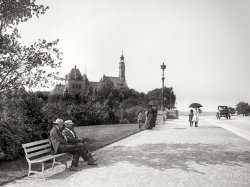
- Chicago Club: 1906
- ... Romanesque building at the southwest corner of Michigan Ave. and Van Buren St. was designed by Burnham and Root and built in ... into its present headquarters two blocks up and across Michigan Avenue in 1893, the building was sold to the Chicago Club. As the ... Wing (street cleaner) with his broom in the foreground
Michigan Avenue or Boulevard? We see here, from left to right, at #:
203 ... Posted by Dave - 09/07/2012 - 12:26pm -
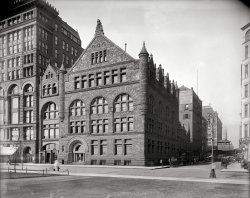
- A Big Load: 1890s
- Michigan circa 1890s. "Logging a big load." Continuing our Michigan travelog. 8x10 inch dry plate glass negative, Detroit Publishing ... Here are a couple photos I used in our project about Michigan White Pine Lumbering in the mid 1800's.
Logging in Upper Michigan ... Posted by Dave - 07/29/2012 - 10:08am -
![A Big Load: 1890s Michigan circa 1890s. "Logging a big load." Continuing our Michigan travelog. 8x10 inch dry plate glass negative, Detroit Publishing Company. View full size.
IncredibleThis picture blows my mind. On the one hand, my first inclination is to call it a gag photo. But there it is -- before the days of Photoshop. On the other hand I am left to wonder: How can two horses pull such an enormous load -- on sled runners no less, in snow-covered dirt? All the lumberjacks present suggest we are at the forest, not the mill. How long is the horse-pull to the mill? How were the logs piled so high? I take it there was a steam derrick somewhere abouts. etc. etc. People want to know, Dave.
Can't resistThose lumberjacks sure have a lot of wood.
Hardly toothpicksHope that load didn't become firewood. Can't tell the species from the bark, but that's marvelous timber -- straight, free of limbs (and, thereby, knots and/or crotch wood) -- and some of the logs must be approaching 3 feet across. I see lots of furniture there.
I'm SpeechlessThese guys are nuts!
2 HPI'm surprised that kind of load can be pulled by only two horses. Hope they don't have to pull it uphill.
PuzzledHow the heck did they stack those logs that high?
How the heck do just two horses pull that load?
Regardless, pretty darned impressive.
Special ShoesThe horses were generally shod with special "clawed" shoes--sort of studded tires of the day. This gave them extra grip in the ice and snow. Also, it would be easier to drag this over the ice (once it was moving)than over dirt roads.
I am a native Oregonian and remember seeing trees like this going through the small towns of my childhood on the back log log trucks.
Maybe the Run is Downhill?But surely even these brawny experts didn't saw the logs so neatly by hand, so there must be a steam-driven saw and crane nearby.
[The trees were felled and sectioned by hand. - Dave]
Double DutyFrom the photo below it appears that the horses not only had to pull the sled, but they had to help load it too.
It's a livingAren't you glad you're not a horse?
Timber SledsHere are a couple photos I used in our project about Michigan White Pine Lumbering in the mid 1800's.
Logging in Upper MichiganThe sleds were pulled on ice roads made by spraying the trails with water. The drivers had to be especially careful going down a grade as the load could overrun the horses. If they had an uphill grade they would add a couple helper horses. Another problem was crossing lakes, if the sled fell through the ice it could pull the horses in. These sleds were a big reason why logging was done in the winter in upper Michigan.
"Life in a Logging Camp"There's an interesting illustrated account of white pine logging in Michigan in the June 1893 issue of Scribner's magazine.
It describes a load of logs "18 feet long, 15 feet wide, and 33 feet 3 inches from the top to the roadbed, weighing over 100 tons ... hauled by a single team" over the specially prepared ice covered roads, and says it "will be placed on the grounds of the Columbian Exposition as one of the wonders of the world."
A book on the era The book "White Pine Days on the Tahquamenon" is a good read on the Michigan logging days.
WowCan you imagine what the forests looked like with all the trees that size?
Pulling PowerTwo impressive draft horses there.
Lumber SealerMy great-grandfather, Albert Schuitema, was a lumber sealer in the early 1900's. Maybe he worked in the vicinity of these pictures. Can anyone tell me what a lumber sealer did?
Down to the RiverThe horses did not pull the sled to the mill. Trees were cut in the winter only and the horses pulled the sled on a pre-iced trail to a river.
The logs were put into the river in the spring and floated to a sawmill. The lumberjacks made a water corral out of some of the logs by chaining them together end to end. The bulk of the logs were put inside the corral.
Steam tugboats pulled the log corrals out into the great lakes and to the sawmills on the main inland rivers. The Tugboats waited in an area where the logs would appear just like a taxi waits for a rider.
This was a seasonal business for the lumberjacks. Winter and spring only.
The Forest TodayThere is still a large piece of virgin forest left in Michigan's U.P., it is called the Porcupine Mountain Wilderness State Park. The park sits along the shore of Lake Superior and is about 70,000 acres. This forest holds the largest stand of unharvested old growth forest east of the Mississippi River. Hike into the interior trails and experience "what it was like" before the upper Midwest was logged. The white pine and hemlock trees are huge, the air is cool and pure, and the silence of the forest is deafening!
Total respectAfter a week of felling and logging up 16 large oaks with the help of two Sthil chainsaws and a powerful quad and trailer I have nothing but respect for those loggers of the past. THEY had it tough!
Lumber sealerA lumber sealer was the fellow who would mark the ends of the lumber with the "seal" of the company who was doing the logging. Remember, this was when logs were driven to the mill down river, the same river that every other logging company used. Marking or "sealing" was a way of identifying your logs from those of other companies at the mill, it's simular to branding cattle.
Shorpy U Rides Again!Once again, I learn more here than I did from living a few years in WA (logging territory) or from even more years in college!
Love the bit about the sealer...
Thanks, guys and gals!
1893 World's Fair LoadThis load of white pine was cut on the Nestor Estate near Ewen, Michigan, in Ontonagon County in the Upper Peninsula. It was a world's record load of more than 36,000 board-feet of lumber. The two horses did indeed pull the load approximately a quarter of a mile. It was then loaded onto railcars, along with the sled, and sent to Chicago. The load was reloaded as part of the Michigan Lumber exhibit at the 1893 Columbia Exposition.
-- Hartwick Pines Logging Museum
Very coolI own my family hunting land and it is located in the northern section of the lower peninsula of Michigan. I think this photo is amazing! All Michigan antique photos mean something to me because my family first settled in MI in 1883 (from Oklahoma on horse carriage)
(The Gallery, DPC, Horses, Mining)](https://www.shorpy.com/files/images/4a03923a.thumbnail.jpg)
- Pennies From Hancock: 1905
- Hancock, Michigan, circa 1905. Another look at copper country. "A modern smelter." With ... you need him Where has that errand boy gone to now?
Michigan Smelter This is the Michigan Smelter at Cole’s Creek, west of Houghton (canal road), albeit the ... Posted by Dave - 12/02/2020 - 2:55pm -
![Pennies From Hancock: 1905 Hancock, Michigan, circa 1905. Another look at copper country. "A modern smelter." With contemporary cows and a bleeding-edge bakery van. 8x10 inch dry plate glass negative, Detroit Publishing Company. View full size.
Never around when you need himWhere has that errand boy gone to now?
Michigan SmelterThis is the Michigan Smelter at Cole’s Creek, west of Houghton (canal road), albeit the photo says Hancock.
[As shown in the photo, Hancock looks slightly closer despite being on the opposite shore. "Pennies From Houghton" certainly sounds better! - Dave]
Making tracks for the Copper RangeA new railroad name to me, I looked up the Copper Range. Dissolved in 1972, it ran 60 miles of trackage from Calumet to McKeever, Michigan. The copper mines it serviced in the Keweenaw Peninsula were called the Copper Range. There is a Copper Range railroad coach car number 60 in a museum but alas, I don't see that one in the photo.
Copper Range RRCheck out the late Kevin Musser's excellent site on the Copper Range . It includes Kevin's plans and efforts for modeling the COPR.
Kevin's family maintains his old site since his death as a memorial for him; it really is excellent.
(The Gallery, DPC, Mining, Railroads)](https://www.shorpy.com/files/images/SHORPY_4a13098a.thumbnail.jpg)
- Michigan Avenue: 1909
- Lansing, Michigan, circa 1909. "Michigan Avenue from the Capitol." 8x10 inch dry plate glass negative, Detroit ... the photo in the earlier comment is from, but this is Michigan Avenue from the Capitol steps.
My Hometown Dave's photo depicts ... Posted by Dave - 02/13/2018 - 5:25pm -
![Michigan Avenue: 1909 Lansing, Michigan, circa 1909. "Michigan Avenue from the Capitol." 8x10 inch dry plate glass negative, Detroit Publishing Company. View full size.
Capitol stepsLuckily, Google provided this ground level view from the steps of the capitol. I don't see any buildings still standing from 1909, and the grand lawn has been replaced with (presumably legislators') parking spots.
[incorrect image removed]
Oops, I did get the wrong side of the capitol building. Thanks for the correction everyone! Please look at the pretty dome, instead!
Actual Capitol StepsI'm not sure which side of the Capitol the photo in the earlier comment is from, but this is Michigan Avenue from the Capitol steps.
My HometownDave's photo depicts the view looking east from the front of the Capitol building. About 5 miles ahead on Michigan Ave. lies the campus of Michigan State University in East Lansing. The statue in the circle is of Governor Austin Blair which was erected in 1895 and still stands. Blair was know as the "Civil War Governor". More can be found of his interesting history here: https://en.wikipedia.org/wiki/Austin_Blair
Archvan's Google view is of the back, or west side, of the Capitol building.
(The Gallery, DPC, Streetcars)](https://www.shorpy.com/files/images/SHORPY-4a23415a1.thumbnail.jpg)
- Michigan Central: 1904
- Circa 1904. "An engineer at his post, Michigan Central R.R." 8x10 inch dry plate glass negative, Detroit Publishing ... example was built by American Locomotive in 1902. The Michigan Central was a longtime subsidiary of the New York Central.
Do The ... Posted by Dave - 07/26/2012 - 5:00pm -
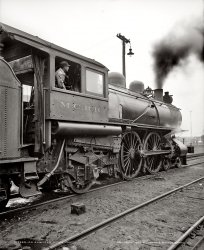
- Batman in Michigan: 1966
- ... a family vacation at Sleepy Hollow Resort in South Haven, Michigan. View full size.
Zowie! Holy Hollow Happiness!
Holy ... drop off the bluff 30 feet onto the sandy shore of Lake Michigan, provided they miss the rental cabins on the overlook.
2 Cent ... Posted by here in van nuys - 07/07/2013 - 2:34pm -
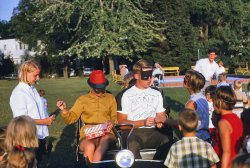
- Michigan Normal: 1902
- Ypsilanti, Michigan, circa 1902. "Starkweather Hall, Students' Christian Association, Michigan State Normal College." Not far from the Ypsi Water Tower . 8x10 ... to last. This one still exists on the campus of Eastern Michigan University per Google Maps. It is adjacent to McKenny Hall and sits ... Posted by Dave - 07/29/2012 - 6:11pm -
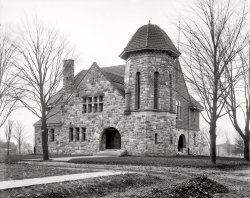
- Hunters in Hanover, Michigan
- Eight men and seven deer about 1895 in Hanover, Michigan.
Back Row Left to Right
1.Wells W. Dew (b.1848, d.1933)
2.Bill ... d.1933)
3.Doc. Hathaway (medical doctor in Hanover, Michigan)
Ralph and A.B Sanderson are cousins. Will Sanderson is the ... Posted by JudyKPfaff - 08/21/2007 - 9:52pm -
- Cunningham Drugs: 1942
- ... View full size.
Cunningham Drugs, based in Detroit Michigan Cunningham Drugs was a chain of stores founded in 1889 operated primarily within the state of Michigan. I remember them well from my childhood in Detroit. They had a soda ... Posted by Dave - 03/23/2021 - 5:37pm -
![Cunningham Drugs: 1942 UPDATE: The view here is of Douglas Street in beautiful Victoria, British Columbia!
The slide mount for this street scene -- the latest (and earliest) Kodachrome from hotrodder-shutterbug Don Cox -- is bereft of notation regarding location. Where are we? View full size.
Cunningham Drugs, based in Detroit MichiganCunningham Drugs was a chain of stores founded in 1889 operated primarily within the state of Michigan. I remember them well from my childhood in Detroit. They had a soda fountain and served a great hamburger. Michigan locations closed and reopened as Apex Drug in 1982 and were later sold to Perry Drug Stores. They finally sold to Walgreens in 1991. Tip of the hat to Wikipedia.
[Wrong Cunningham Drug. - Dave]
https://en.wikipedia.org/wiki/Cunningham_Drug_(Canada)
Northwest Corner of Douglas and Yates, Victoria, BThe building is still there, minus the top of the turret: https://goo.gl/maps/kPwwNQzq1MXjcAM2A
Location for 3/21 photoI found mention of a Cunningham Drugs in Victoria, British Columbia. There was a postcard on ebay with the words "Peter-Pan-Cunningham-Drugs-Douglas-St-Victorai-British-Columbia-postcard-1950s". The bus' destination in this photo says "Burnside Marigold" which is an intersection in Victoria.
Never ...ever step back to admire your work.
Victoria British ColumbiaAppears to be 1300 Douglas Street.
We're in CanadaTo be more precise, we're in Victoria, British Columbia. Cunningham Drugs on the corner was located at 1300-1306 Douglas Street; the building still exists, the drugstore does not.
Victoria, B.C.Next to Cunningham Drugs is McLean's Bakery, which was located at 1304 Douglas Avenue in Victoria, British Columbia, Canada.
Here is the Google Street View of these storefronts as they appeared in May 2018.
Something tells meThis is British Columbia's capital city, beautiful Victoria.
Victoria BCDouglas and Yates in Victoria, B.C Canada!
Tags + KodachromeThese two together narrow the probable date range to 1946-47. Almost all photographic film and equipment, at least in the US where Kodachrome was made, was reserved for the "war effort". Consumers had difficulty purchasing any photographic materials until well into 1946.
When my dad came back from the war, he wanted to buy a new camera to replace the one he inherited from his father who used it during WW1. He had to wait until 1947 before the Kodak Vigilant 620 was available with the faster f/4.5 lens he wanted. Only the version with the simpler f/6.3 lens was available earlier, and that not until 1946.
[This exposure is from a batch of slides taken in the Pacific Northwest, many of them dated 1942. Don Cox was a Navy photographer's mate. One of his previous images is this Kodachrome from 1943. - Dave]
Good info. A Navy photographer's mate would have had access to materials, Kodachrome in this case, that the average civilian wouldn't have had.
Victoria, BCI believe this to be Victoria, British Columbia - Cunningham Drugs was a well known chain in BC during this time and Burnside/Marigold on the bus is another clue - Burnside Rd, Marigold Park.
Location Victoria Island Coach Lines LTD. The street sign Points to Sidney, BC.
Looks like it's Victoria BCThe bus company initials - Vancouver Island Coach Lines Ltd. (15 November 1928 - 1950) and street sign pointing us to Sidney, which is where the BC Ferries now dock, tells me this is probably Victoria, BC.
Not Danforth & Pape... but rather Douglas & Yates, in Victoria, British Columbia:
Douglas Street runs concurrent with Trans-Canada Highway 1 in Victoria. In fact, the Zero Mile Monument is not far from this intersection.
North of the BorderA quick search for that Burnside-Marigold bus brings up an archival photo from Victoria, B.C.: https://search-bcarchives.royalbcmuseum.bc.ca/burnside-marigold-bus-on-b...
Victoria, British ColumbiaThis picture is taken at the corner of Douglas and Yates in Victoria, B.C. Google streetview shows that most of the block is still there. Names like "Copp the Shoe Man" and "Cunningham Drugs" were well known B.C. companies. I worked for Cunningham Drugs for a while as a teenager in the 1970s.
The bus in the picture is Vancouver Island Coach Lines and its route is Burnside - Marigold. And the dark blue sedan in the middle of the street looks like it might be a 1929 Auburn.
Looks to me like ...Vancouver, B.C.
Found itThe location is 1302 Douglas Street in Victoria, British Columbia (corner of Yates and Douglas). The spire and the some of the parapet on top of the Cunningham Drug store are gone now but otherwise the street is remarkably the same.
"For the unrelated Canadian chain, see Cunningham Drug (Canada)."
TagsThe only years B.C. did not use front license plates were 1942 thru 1947, as a wartime metal conservation effort. So we can date this photo from during World War II or just after.
Douglas Street, Victoria B.C.Cross' Marketeria was at 1310 Douglas in Victoria, BC. Here's what it looks like today:
Douglas Street, Victoria, BC, Canada?Just a guess. I know United Cigar Stores LTD was a Canadian retailer, V.I.C.L., Ltd on the bus I guess to mean something like Vancouver Island Coach Line, the direction sign points to Sidney which is a town near Victoria, Douglas Street seems to be a good main drag downtown to put hotel on. St James Hotel counters my reasoning but you can’t have everything.
At the far right ...... we see the Douglas Hotel at 1450 Douglas Street and the Victoria City Hall at the corner of Douglas Street and Pandora Avenue, an example of Second Empire-style public architecture.
That 'scaffolding'The day before OSHA was created.
Accident waiting to happenWow. Two men on a sagging scaffold with people under it.
Rock steady!Is there any way to know whether Don Cox used a tripod for his photos? If not, then he could certainly hold still when he needed to.
Laurel and Hardy on locationI don't recall Cunningham's signs being any color but green, maybe it is a Canadian Thing.
The sign painters' physiques, the bow in the scaffold plank, the can of paint and the pedestrian below in trench coat and hat. It is a fine line between tragedy and comedy.
Curiously familiarThis looks very much like R Crumb in Kodachrome.
(Most) Trades workers of YoreSeemed to survive:
No hard hats
No gloves
No safety harnesses
No safety goggles
No ear protection
No high visibility jackets
No steel capped boots
No traffic and pedestrian control monitors
No pedestrian bypass barriers
No proper scaffolding
No safety inspectors
No license (usually) required to close off part of street/sidewalk
No dust or chemical spill controls
(The Gallery, Kodachromes, Cars, Trucks, Buses, Don Cox, Stores & Markets)](https://www.shorpy.com/files/images/SHORPY-P-0020.thumbnail.jpg)
- The Michigan Assassin: 1908
- ... this photo was made -- middleweight champion Ketchel (the "Michigan Assasssin") fatally shot in a training-camp robbery in 1910, and ... Posted by Dave - 07/16/2015 - 10:13am -
![The Michigan Assassin: 1908 San Francisco, 1908. "Boxer Stanley Ketchel at wheel of American Underslung auto with manager Britt Willis." Both of whom would be dead not long after this photo was made -- middleweight champion Ketchel (the "Michigan Assasssin") fatally shot in a training-camp robbery in 1910, and Willis the victim of a "violent stomach hemorrhage" in 1909. Their car, an American Underslung, was among the first to employ the now-universal dropped frame, with the bottom of the car below the axles. 6½ x 8½ glass negative by Dana Studio, from the collection of George Whitney Jr. (1922-2002), owner of the Cliff House restaurant. View full size.
Rogues' GalleryEvery person in this picture looks like trouble (except for the girls -- they just look scared).
Unmatched wheelsThey're the same style and it's hard to tell from this distance if they are the same size. But the rears have extra spokes and segments. I wonder why?
[To withstand the stresses of acceleration and braking. - Dave]
SF 1908Stanley Ketchel fought 2 fights in San Francisco in 1908 at the Coliseum, on 31 July he fought Hugo Kelly and won with a KO in the 2nd, a week later he defeated Joe Thomas by TKO in the 3rd.
Huh?There seems to be a multi note steam whistle on the side of the car. I don't think even Stanleys had those.
FOTOGRAFHER?I assume the "FOTOGRAFHER" sign above means "PHOTOGRAPHER"? Where did this weird spelling come from?
["Fotografer" (not "fotografher") means "photographers" in Swedish, Danish and Norwegian. -tterrace]
Ketchel KilledFascinating story of the murder of Stanley Ketchel here.
TiresCurious about the multiple "valve stems" in the rim. Can't recall seeing this on other photos of the era. Any ideas? Also what is the pressure vessel mounted horizontally of step? Is it the source to blow the massive horn coming out of the cowl?
[The wheels have tire clamps, which are addressed in this comment thread about a contemporaneous auto. -tterrace]
Quite a set of driving gloves.The long gauntlet was clearly intended to keep the wind from blowing up one's sleeve, and kept the sleeve from catching on other things on the car, like the shift lever.
The tank on the running board -- is almost certainly holding acetylene, which is used in the headlights.
(The Gallery, Cars, Trucks, Buses, San Francisco, Sports)](https://www.shorpy.com/files/images/SHORPY-363-01.thumbnail.jpg)
- Michigan Mystery #3
- ... a camping trip from the Watertown area of Wisconsin into Michigan through Michigan's Upper Peninsula. I'm trying to figure out where these were taken, ... Posted by mamyers - 08/24/2012 - 9:45pm -
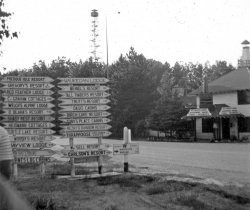
- Michigan West: 1937
- October 1937. "Main street in Michigan, North Dakota." Medium format acetate negative by Russell Lee for the ... Worth Selling? From the looks of the main street in Michigan now I would venture to say beer only provided short term gains since ... Posted by Dave - 12/03/2019 - 6:48pm -
![Michigan West: 1937 October 1937. "Main street in Michigan, North Dakota." Medium format acetate negative by Russell Lee for the Farm Security Administration. View full size.
Occasio PraecepsDave -- Your update on "Ars est longa. . ." is a masterpiece as an example of the unregenerate punster's relentless eye for opportunities to create groans, giving the lie to "iudicium difficile."
Still Going StrongThe "Johnson Store" is still alive and kicking.
I came to town for three things1. Schmidt's. Check.
2. Peerless. Check.
3. Old Heidelberg. Check.
Is Beer Worth Selling?From the looks of the main street in Michigan now I would venture to say beer only provided short term gains since the last business standing is the only one without a beer sign.
[Johnson longa, fermenta brevis! - Dave]
(The Gallery, Frontier Life, Russell Lee, Small Towns)](https://www.shorpy.com/files/images/SHORPY-8c18009a1.thumbnail.jpg)
- The Pontch Again: 1912
- Detroit, Michigan, circa 1912. "Hotel Pontchartrain." Yet another view of this ... Posted by Dave - 11/08/2023 - 5:20pm -
![The Pontch Again: 1912 Detroit, Michigan, circa 1912. "Hotel Pontchartrain." Yet another view of this relatively short-lived hostelry on Woodward Avenue, whose downfall was a paucity of private bathrooms. Familiar landmarks include the Soldiers' and Sailors' Monument, Cadillac Square and the Cadillac Chair. 8x10 inch glass negative, Detroit Publishing Company. View full size.
"Misfit"I wonder what went down at "MISFIT"? Or did they just sell irregular clothing? And what could those fellas on the corner be taking a gander at?
[Misfit was the haberdashery owned by Sol Berman at 120 Woodward Avenue. The headline below is like something out of the Onion. - Dave]
Anywhere you wantThere do not seem to be much in the way of parking regulations yet. Check out the street in front of the hotel.
Nice Cleanup DaveI downloaded the original image from the LOC a while back. You've done a very nice cleanup job for the Shorpy site! Thank you.
[Thanks, but I didn't do any "cleaning up." - Dave]
My mistake. I'm confusing this image with a sister image you've previously posted that was pretty distressed.
Cheep lodgingsHenry Ford had a purple martin bird house at his home Fairlane that he called the Hotel Pontchartrain. Don't know if Albert Kahn was the architect.
You'd Almost ThinkApparently, the plethora of windows was no offset for the paucity of bathrooms.
Street sightingOdd load waiting to cross the street. Coil of rope? Life preserver? Spare tire?
Aha! Much clearer in closeup. The fellow is obviously hefting a coil of rope headed for a nearby ship chandlery.
(The Gallery, Detroit Photos, DPC, Streetcars)](https://www.shorpy.com/files/images/4a19783a.thumbnail.jpg)
- Michigan Riviera: 1910
- ... Several landmarks stand out, all on Fort Street:
- Michigan Central Railroad Depot, on the left, demolished
- Fort ... a professor of naval architecture at the University of Michigan who testified about metacentric heights and their importance to ... Posted by Dave - 05/12/2018 - 10:51pm -
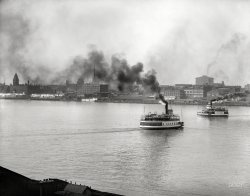
- Honeymoon Hotel: 1941
- August 1941. "Boardinghouse in Baraga, Michigan," a.k.a. the Honeymoon Hotel. View full size. Medium format safety ... in April 1936. - Dave]
No, no Toto, we are in Michigan! Yay, finally a photo from my home area. This is the old Honeymoon ... Posted by Dave - 06/28/2008 - 11:11am -
![Honeymoon Hotel: 1941 August 1941. "Boardinghouse in Baraga, Michigan," a.k.a. the Honeymoon Hotel. View full size. Medium format safety negative by John Vachon for the FSA. This was scanned from an uncaptioned and somewhat misfiled print of the negative. Thanks to Anonymous Tipster for pointing us in the right direction (north).
Wait, Toto, we are in KansasI would guess this was in Kansas. Not many, if any, of these Second Empire style houses in Oklahoma. Kansas had the earlier settlements that would have built in this style, when Oklahoma was Indian Territory.
[This call number for this photo puts it in a batch of pictures taken in Cimarron County, Oklahoma, in April 1936. - Dave]
No, no Toto, we are in Michigan!Yay, finally a photo from my home area. This is the old Honeymoon Hotel in Baraga, Michigan, on the Keweenaw Bay Indian Reservation in the Upper Peninsula. This view looks east toward downtown Baraga and across the bay of Keweenaw with the town of L'Anse on the far side. For another view of this once stately building, see:
http://www.highway41north.com/baraga.html
Scroll down to 1940's, pictures #3 and #4. Thanks to Shorpy for this photo even though not as intended but perhaps it will open to its viewers an area that is rich in Indian, fur trade, lumbering, mining history and say, saloons, houses of ill-repute, safehavens for 1930's Chicago gangsters, and yes, I work in a building just a stone's throw from where this photo was taken....
[Oklahoma, Kansas ... Michigan. And it's by John Vachon, not Arthur Rothstein. From 1941, not 1936. So I was pretty close! Caption updated. Thanks. - Dave]
Not another view - same photoVery interesting - the picture #3 that you reference isn't just another view of the same building - as far as I can tell it's the exact same photo. Makes one wonder about the path they've both taken to make it onto the web. Presumably the picture#3 image is scanned from a print...
[Pics #2 thru #5 on Highway41north.com are all from the LOC archive and were taken by John Vachon. #3 is a low-res scan of a negative; our photo was scanned from a print. - Dave]
Some honeymoon!Lovely accommodations for Mr. and Mrs. Bates.
While in the neighborhood....The buildings noted in Highway41north.com, #2, #3/#4 are long gone but St. Anne's Catholic Church in #5 looks pretty much the same however it has an addition towards the rear and some needed landscaping around the steps....
Looks Like a Hopper PaintingThat sky is spooky. Not a soul in sight. Amazing photo.
Cool! My jaw dropped when I saw the pic and caption! I grew up in this area, and it's always fun to stumble upon these things on the web!! Thanks for posting, and thanks to the previous poster for the website with all the other pictures! I am a sucker for history and historical buildings and how things were back then.... This is a very haunting building... I love the ambience of it.
Very cool!
Forty years earlier...The hotel 40 years earlier.
(The Gallery, John Vachon, Rural America)](https://www.shorpy.com/files/images/8c36807u.thumbnail.jpg)
- Michigan Mystery #1
- ... a camping trip from the watertown area of Wisconsin into Michigan through Michigan's Upper Peninsula. I'm trying to figure out where these were taken, ... Posted by mamyers - 08/24/2012 - 9:46pm -
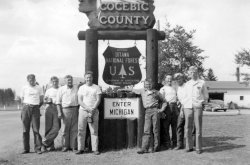
- Michigan Manselet: 1910
- Circa 1910. "Morgan residence -- St. Clair Flats, Michigan." 8x10 inch dry plate glass negative, Detroit Publishing Company. ... Posted by Dave - 10/02/2016 - 4:06pm -
